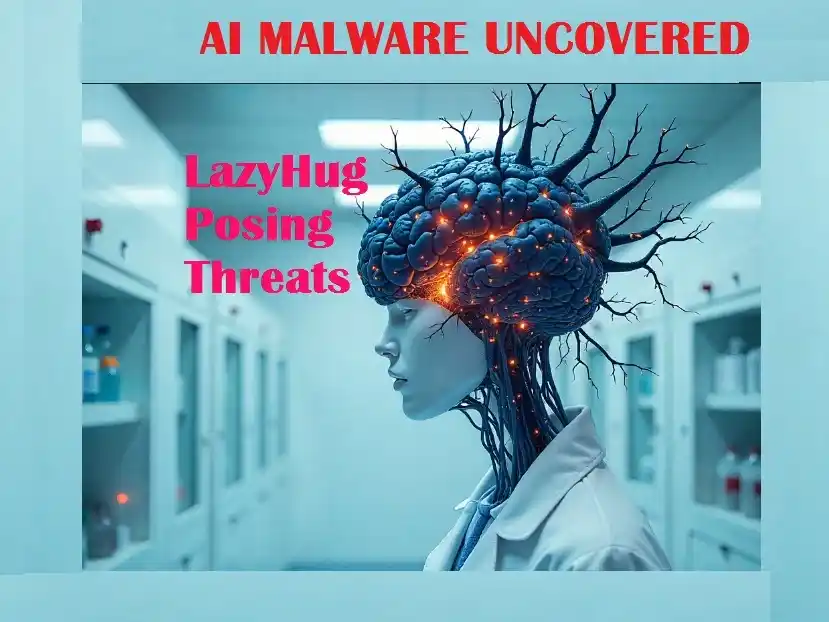Cybersecurity is no longer a long-term battle against human hackers only. Digital threats have become smarter and more dangerous than you have ever imagined. Of course, AI has become a powerful weapon to beat cyber threats. However, it also has the power to generate malware. AI-driven malware has created an alarming situation in the cyber world. But, the most notorious one in recent days is LazyHug. This malware is driven by the same technology that runs Gemini, ChatGPT, and Perplexity.
Let’s discuss AI-driven cyber attacks and the rise of LazyHug, which outsmarts traditional security defenses.
What is AI Malware?
The use of AI in cybercrime has posed new threats to organizations and individuals. Traditional malware relies only on pre-written code and shows fixed behaviors. But, AI-generated malware adapts dynamically, learns new things in real-time, and optimizes its cyber-attacks.
It is challenging to detect and combat AI malware because it evades traditional security programs by adjusting its appearance and behavior. Its precision targeting ability makes it distinct from traditional malware.
AI-driven malware can-
- Convince phishing emails
- Detect system vulnerabilities
- Simulate human-like behavior
AI malware attacks give victims little to no time to respond. What’s more, AI-powered malware has autonomous improvement ability by analyzing successes and failures. When its first attempt does not work, the malware tweaks its code automatically. Thus, the merging of malware and AI has caused a new concern for cybersecurity professionals.
According to Golo Muhr (a reputed Malware Reverse Engineer working with IBM), “Generative AI, which is useful for legitimate software development, is now used by cyber criminals for malicious purposes.
(You can read our blog on generative and responsive AI)
How Do Cybercriminals Use AI In Malware Creation?
Cybercriminals deploy AI in various ways-
- Automatically create codes for malware– Hackers use AI-assisted coding tools to develop custom malicious programs.
- Spread malware– Many malware creators integrate AI features into software that cause automatic modification of malicious code.
- Identify targets– AI technologies enable attackers to detect vulnerable targets, such as weak passwords.
What Are Different Types of AI Malware?
We can categorize AI malware programs in various ways-
- Adaptive malware– The malicious software automatically alters its behavior, making it difficult to remove or block.
- AI-driven botnets– Botnets are compromised devices used by cyber attackers to distribute spam and malicious content. They use AI technology to strengthen their attack techniques.
- Dynamic malware payloads– Malware often uses AI technologies to create unique payloads for every target device. Dynamic malware payloads have made it difficult to identify malicious programs, as every payload looks different.
LazyHug- The First Known AI Malware
LazyHug is a new type of AI-generated malicious program that steals data from your Windows computer. A national cyber defense team in Ukraine discovered this AI malware.
LazyHug uses Qwen-2.5-coder-32B-Instruct, a type of open-source AI model created by Alibaba. It accepts simple textual instructions and turns them into computer code. There is no need for pre-programming to make the malware work.
Written in Python, the malware enables hackers to modify how the malicious program works.
How Does Lazyhug Enter Your Computer?
LazyHug developers deliver emails and pretend to be Ukrainian government executives. Their emails include a ZIP file that appears to have some useful content. The files in the ZIP folder contain a virus.
So, if you open the ZIP files by clicking on them, LazyHug automatically gets installed. You would get no pop-ups or warning messages, but the malware would start running in the background.
LazyHug can scan your Desktop folders, Documents, and Downloads. Both PDF and text files are scannable to LazyHug.
LazyHug is a silent theft, causing no computer slowdown and no antivirus alarm.
Why is Lazyhug More Dangerous than Other AI Malware Attacks?
This is the first time malware is generating executable commands with LLM. So, cybercriminals can continue the attack just by altering the commands. Static analysis and security software cannot easily detect such malware. You might have heard about Skynet, which evades AI tools. But, LazyHug is riskier than other malicious programs.
What is an Example of a Malicious Use of AI?
We have listed some real-life AI malware examples
Cybercriminals used AI technologies to breach the TaskRabbit online marketplace. They stole more than 3.75 million records of financial and personal user details.
Yum! Brands, the parent brand of Pizza Hut and KFC, experienced an AI-driven ransomware attack. It resulted in the closure of several UK-based outlets of KFC and Pizza Hut for weeks.
John Erin Binns, a hacker, stole the mobile operator’s customer records through AI tools.
What are the Best AI Malware Detection Strategies?
According to the latest AI malware statistics, AI-assisted malware could compose almost 20% of new strains in 2025. So, it is worth implementing various strategies to identify and fight against AI-assisted malware attacks.
A basic AI malware detection model does not work. So, you need to implement highly advanced strategies to find malware-
- Monitor the processes and your applications’ behavior to find anomalies, which are signs of malware.
- Analyze network data to identify connections to unknown hosts and AI services.
- Check user behavior that detects unusual patterns, revealing the malware.
- Use threat intelligence to deal with various types of AI-driven malware attacks and block them proactively.
Summing Up
The rapid AI integration into cybercrime and cybersecurity has marked a shift in the online landscape. It reshapes the rules for engaging defenders and attackers. The dark AI allows cybercriminals to launch more adaptive attacks. However, adopting the latest security technologies is not the only solution. You have to foster a culture of education and vigilance.

